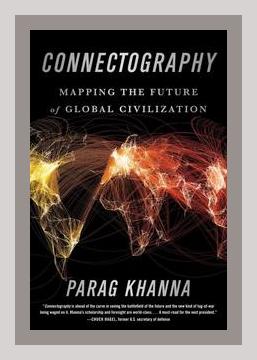Business StrategyBusiness Ecosystems
Summary: Connectography: Mapping the Future of Global Civilization by Parag Khanna
I. Introduction
Parag Khanna’s Connectography: Mapping the Future of Global Civilization explores the transformation of global connectivity and its implications for the future of our world. Published in 2016, the book delves into how infrastructure, supply chains, and connectivity are defining new geopolitical realities, replacing traditional boundaries and reshaping human interactions and business ecosystems. Khanna emphasizes that the world’s future will be increasingly about connectivity and less about territory.
II. The Age of Connectivity
Major Point: Infrastructure as the Backbone
– Concrete Example: Khanna cites the construction of the New Silk Road, a massive network of railways, highways, and pipelines stretching from China to Europe. This modern initiative reflects a significant shift towards prioritizing connectivity over traditional geopolitical strategies.
Actionable Advice: Embrace the role of connectivity in both personal and business strategies. For example, an individual or company could focus on building diverse communication channels and partnerships that transcend national borders, acknowledging the power of infrastructural investments.
III. Supply Chain Transformations
Major Point: The Evolution of Supply Chains
– Concrete Example: Khanna details how companies like Apple design their products in California, manufacture components in various Asian countries, and assemble them in China. This global supply chain model demonstrates how connectivity enhances efficiency and innovation.
Actionable Advice: Diversify supply chains and seek international partnerships to enhance efficiency and resilience. Companies should invest in technologies that allow real-time tracking and management of global supply networks.
IV. Urban Networks as Hubs of Connectivity
Major Point: Cities as Centers of Economic Power
– Concrete Example: Khanna discusses how megacities like New York, London, and Tokyo are not just large cities but critical nodes in a global network of commerce, culture, and connectivity. Through transport systems, financial markets, and digital networks, these cities hold immense influence.
Actionable Advice: Entrepreneurs and businesses should establish a presence or connections in major urban centers. For instance, setting up offices or partnerships in these cities can provide access to vast resources, talent pools, and markets.
V. The Redefinition of Borders and Sovereignty
Major Point: The Declining Relevance of Traditional Borders
– Concrete Example: Khanna illustrates with the European Union, where political borders are softening due to economic and infrastructural integration. The Schengen Area allows for passport-free movement, facilitating business and personal connectivity across member states.
Actionable Advice: Focus on global citizenship rather than limiting oneself to national boundaries. Consider opportunities for work, education, and business that are not confined by traditional geopolitical borders. Leveraging remote work and digital platforms can significantly expand one’s reach.
VI. Technological Advancements and Digital Connectivity
Major Point: Digital Networks as New Frontiers
– Concrete Example: Khanna points to the rise of digital platforms such as Alibaba, which connects millions of buyers and sellers worldwide, creating a virtual marketplace that is borderless and operates 24/7.
Actionable Advice: Invest in and adopt digital platforms that enhance global connectivity. Both businesses and individuals should leverage e-commerce, social media, and communication tools to access and engage with a global audience.
VII. Connectivity and Economic Integration
Major Point: Economic Zones and Trade Agreements
– Concrete Example: Khanna discusses the significance of trade agreements like NAFTA and the Trans-Pacific Partnership (TPP) in boosting connectivity and economic integration, despite political debates.
Actionable Advice: Stay informed about international trade agreements and economic zones to identify new markets and growth opportunities. Businesses, in particular, should explore how such agreements can facilitate easier access to resources and customers.
VIII. Connectivity and Environmental Sustainability
Major Point: Infrastructure Planning for Sustainability
– Concrete Example: Khanna cites China’s investment in renewable energy infrastructure, such as the world’s largest solar farms, as an example of coupling connectivity with environmental foresight.
Actionable Advice: Integrate sustainability into connectivity projects. Whether in urban planning or business operations, prioritizing environmentally friendly practices can lead to long-term benefits and compliance with global standards.
IX. Connectivity-Induced Inequality and Mitigation
Major Point: Addressing the Inequality Gap
– Concrete Example: Khanna addresses how unequal access to connectivity results in economic disparities, using examples from underdeveloped regions that lack infrastructure.
Actionable Advice: Advocate and invest in initiatives aimed at improving connectivity in underserved areas. Support policies and programs that bridge the digital divide, providing equal opportunities for education and economic participation.
X. Security in a Connected World
Major Point: Cybersecurity and Digital Defense
– Concrete Example: Khanna highlights the rise in cyberattacks and the need for robust cybersecurity measures, citing incidents like the 2014 Sony hack to illustrate vulnerabilities.
Actionable Advice: Implement comprehensive cybersecurity protocols to protect against digital threats. Regularly update security measures and educate stakeholders on best practices to safeguard sensitive information.
XI. Global Governance and Collaborative Networks
Major Point: New Models of Global Governance
– Concrete Example: Khanna discusses networks like the World Trade Organization and the World Health Organization as examples of governing bodies that facilitate cooperation and connectivity on a global scale.
Actionable Advice: Engage with international organizations and collaborative networks. Participation in global forums and policy-making bodies can enhance one’s influence and contribute to shaping a more interconnected world.
XII. Adaptive Strategies for a Connected Future
Major Point: Flexibility and Adaptability
– Concrete Example: Khanna underscores how businesses must adapt to rapidly changing connectivity landscapes, highlighting companies like IBM that have shifted focus from hardware to cloud computing and AI to keep pace with technological advancements.
Actionable Advice: Cultivate flexibility and open-mindedness. Both individuals and organizations should prioritize continuous learning and adaptability to stay relevant in a dynamic, connected world.
Conclusion
Connectography presents a compelling argument that the future of global civilization is centered around connectivity rather than traditional geopolitical power structures. Khanna’s insights encourage leveraging global interconnectedness to foster economic growth, sustainability, and equality. By embracing the power of infrastructure, digital networks, and global collaboration, individuals and businesses can navigate and thrive in this evolving landscape. Through specific actionable strategies, one can optimize for a future defined by connectivity and integration.
